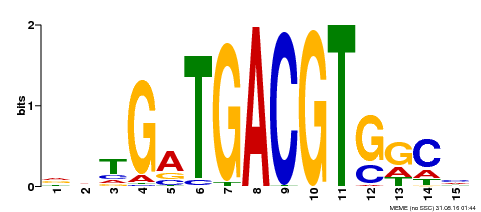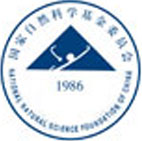 |
PlantRegMap/PlantTFDB v5.0
Plant Transcription
Factor Database
|
| Home TFext BLAST Prediction Download Help About Links PlantRegMap |
Transcription Factor Information
| Basic Information? help Back to Top | |||||||||
|---|---|---|---|---|---|---|---|---|---|
| TF ID | Solyc08g061130.2.1 | ||||||||
| Common Name | HY5 | ||||||||
| Organism | |||||||||
| Taxonomic ID | |||||||||
| Taxonomic Lineage |
cellular organisms; Eukaryota; Viridiplantae; Streptophyta; Streptophytina; Embryophyta; Tracheophyta; Euphyllophyta; Spermatophyta; Magnoliophyta; Mesangiospermae; eudicotyledons; Gunneridae; Pentapetalae; asterids; lamiids; Solanales; Solanaceae; Solanoideae; Solaneae; Solanum; Lycopersicon
|
||||||||
| Family | bZIP | ||||||||
| Protein Properties | Length: 159aa MW: 17341.2 Da PI: 10.4138 | ||||||||
| Description | bZIP family protein | ||||||||
| Gene Model |
|
||||||||
| Signature Domain? help Back to Top | |||||||
|---|---|---|---|---|---|---|---|
| No. | Domain | Score | E-value | Start | End | HMM Start | HMM End |
| 1 | bZIP_1 | 46.2 | 1e-14 | 84 | 144 | 1 | 61 |
XXXXCHHHCHHHHHHHHHHHHHHHHHHHHHHHHHHHHHHHHHHHHHHHHHHHHHHHHHHHH CS
bZIP_1 1 ekelkrerrkqkNReAArrsRqRKkaeieeLeekvkeLeaeNkaLkkeleelkkevaklks 61
+ke kr +r+ +NR++A+ R+RKka++ Le +vkeLe++N +L ++l++l++e + l+
Solyc08g061130.2.1 84 DKENKRLKRLLRNRVSAQQARERKKAYLIDLEARVKELETKNAELEERLSTLQNENQMLRH 144
5899****************************************************98865 PP
| |||||||
| Protein Features ? help Back to Top | ||||||
|---|---|---|---|---|---|---|
| Database | Entry ID | E-value | Start | End | InterPro ID | Description |
| SMART | SM00338 | 4.4E-14 | 84 | 148 | IPR004827 | Basic-leucine zipper domain |
| Pfam | PF00170 | 6.8E-14 | 85 | 145 | IPR004827 | Basic-leucine zipper domain |
| PROSITE profile | PS50217 | 12.461 | 86 | 149 | IPR004827 | Basic-leucine zipper domain |
| SuperFamily | SSF57959 | 3.13E-13 | 88 | 146 | No hit | No description |
| Gene3D | G3DSA:1.20.5.170 | 1.0E-16 | 88 | 148 | No hit | No description |
| CDD | cd14704 | 4.76E-16 | 89 | 140 | No hit | No description |
| PROSITE pattern | PS00036 | 0 | 91 | 106 | IPR004827 | Basic-leucine zipper domain |
| Gene Ontology ? help Back to Top | ||||||
|---|---|---|---|---|---|---|
| GO Term | GO Category | GO Description | ||||
| GO:0006355 | Biological Process | regulation of transcription, DNA-templated | ||||
| GO:0009585 | Biological Process | red, far-red light phototransduction | ||||
| GO:0009737 | Biological Process | response to abscisic acid | ||||
| GO:0009740 | Biological Process | gibberellic acid mediated signaling pathway | ||||
| GO:0010099 | Biological Process | regulation of photomorphogenesis | ||||
| GO:0010114 | Biological Process | response to red light | ||||
| GO:0010218 | Biological Process | response to far red light | ||||
| GO:0010224 | Biological Process | response to UV-B | ||||
| GO:0031539 | Biological Process | positive regulation of anthocyanin metabolic process | ||||
| GO:0042753 | Biological Process | positive regulation of circadian rhythm | ||||
| GO:0080167 | Biological Process | response to karrikin | ||||
| GO:0005634 | Cellular Component | nucleus | ||||
| GO:0003690 | Molecular Function | double-stranded DNA binding | ||||
| GO:0003700 | Molecular Function | transcription factor activity, sequence-specific DNA binding | ||||
| GO:0043565 | Molecular Function | sequence-specific DNA binding | ||||
| Sequence ? help Back to Top |
|---|
| Protein Sequence Length: 159 aa Download sequence Send to blast |
MQEQATSSIA ASSLPSSSER SSSSALHHEL KEGMESDDEI RRVPEMGGEA TGTTSASGRD 60 GVSAAGQAQP SAGTQRKRGR SPADKENKRL KRLLRNRVSA QQARERKKAY LIDLEARVKE 120 LETKNAELEE RLSTLQNENQ MLRHILKNTT AGAQEGRK* |
| 3D Structure ? help Back to Top | ||||||
|---|---|---|---|---|---|---|
| PDB ID | Evalue | Query Start | Query End | Hit Start | Hit End | Description |
| 2oqq_A | 7e-16 | 109 | 148 | 3 | 42 | Transcription factor HY5 |
| 2oqq_B | 7e-16 | 109 | 148 | 3 | 42 | Transcription factor HY5 |
| Search in ModeBase | ||||||
| Expression -- UniGene ? help Back to Top | ||||||
|---|---|---|---|---|---|---|
| UniGene ID | E-value | Expressed in | ||||
| Les.3543 | 0.0 | flower| fruit| leaf | ||||
| Functional Description ? help Back to Top | ||||||
|---|---|---|---|---|---|---|
| Source | Description | |||||
| UniProt | Transcription factor that promotes photomorphogenesis in the light and positively regulates fruit pigmentation and fruit nutritional quality. Probably acts downstream of the light receptor network and directly affects transcription of light-induced genes. {ECO:0000269|PubMed:15178762}. | |||||
| Function -- GeneRIF ? help Back to Top | ||||||
|---|---|---|---|---|---|---|
|
||||||
| Binding Motif ? help Back to Top | |||
|---|---|---|---|
| Motif ID | Method | Source | Motif file |
| MP00117 | ampDAP | Transfer from AT5G11260 | Download |

| |||
| Cis-element ? help Back to Top | |
|---|---|
| Source | Link |
| PlantRegMap | Solyc08g061130.2.1 |
| Regulation -- PlantRegMap ? help Back to Top | ||||||
|---|---|---|---|---|---|---|
| Source | Upstream Regulator | Target Gene | ||||
| PlantRegMap | Retrieve | Retrieve | ||||
| Annotation -- Nucleotide ? help Back to Top | ||||||
|---|---|---|---|---|---|---|
| Source | Hit ID | E-value | Description | |||
| GenBank | AJ011914 | 0.0 | Solanum lycopersicum mRNA for THY5 protein | |||
| Annotation -- Protein ? help Back to Top | |||||||
|---|---|---|---|---|---|---|---|
| Source | Hit ID | E-value | Description | ||||
| Refseq | NP_001234820.1 | 1e-109 | transcription factor HY5 | ||||
| Swissprot | Q9SM50 | 1e-110 | HY5_SOLLC; Transcription factor HY5 | ||||
| TrEMBL | A0A0V0HHN3 | 1e-105 | A0A0V0HHN3_SOLCH; Putative transcription factor HY5-like | ||||
| STRING | Solyc08g061130.2.1 | 1e-108 | (Solanum lycopersicum) | ||||
| Orthologous Group ? help Back to Top | |||
|---|---|---|---|
| Lineage | Orthologous Group ID | Taxa Number | Gene Number |
| Asterids | OGEA8037 | 24 | 30 | Representative plant | OGRP2081 | 17 | 37 |
| Best hit in Arabidopsis thaliana ? help Back to Top | ||||||
|---|---|---|---|---|---|---|
| Hit ID | E-value | Description | ||||
| AT5G11260.1 | 2e-43 | bZIP family protein | ||||
| Link Out ? help Back to Top | |
|---|---|
| Phytozome | Solyc08g061130.2.1 |
| Entrez Gene | 543733 |
| Publications ? help Back to Top | |||
|---|---|---|---|
|
|||



